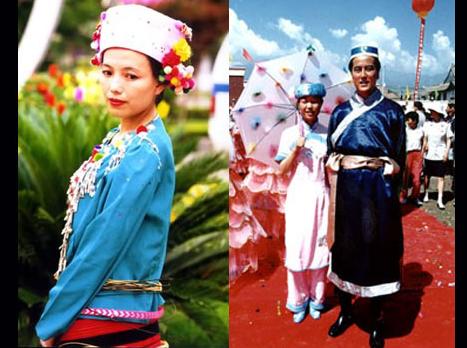
Influenced by the Mongolian nationality, early costumes of Bonan people were basically the same with those of the Mongolian nationality. Both men and women wore fur-lined gowns and various fur caps in winter, and lined gowns and tall flare felt caps in summer and autumn. They also wore multi-colored silk waistbands with trinkets.
During the Xianfeng period in the Qing dynasty, Bonan people were living in Tongren, Qinghai province. Affected by costumes of the Tibetan and Tu nationalities, they wore tilted-front gowns, kaftans and hats in spring, summer and autumn. Some men wore high-necked short white gowns and black waistcoats over the short gowns. Young people usually wore "Rou na", a kind of robe that has slanting collar and front and resembles Tibetan gown in style. Elder people wore dark green, blue and grey cotton coat, dark green medallion satin coats with a front opening and a rear slit, and loose-crotched trousers. Leggings were worn in autumn. Young men preferred caps that were crowned red, yellow or blue and fronted with fox fur. As the cap looked like an eagle about to take flight, it was thereby named "eagle" cap. In summer, men always wore round-mouth shoes and white silk stockings or cloth socks. In winter, they wore shoes named "Suo ba". Such shoes had one-inch thick soles, protruding toe caps with fur ridges and slightly rolled-up toes, and cruciate-flower pulu uppers called "Mu rui" in Bonan language.
During the Tongzhi period in the Qing Dynasty, Bonan people migrated to Gansu Province. After that, they established a close relationship with other nationalities like Hui, Dongxiang and Han nationalities. Under influences of those nationalities and out of necessity of production activities, costumes of Bonan nationality experienced notable changes.
In daily life, men usually liked to wear a kind of yarmulka made of white or black cloth, commonly referred to as Hao caps. They wore white shirts leaving one sleeve outside from the right shoulder, dark green cloth waistcoats over the shirts, and riding boots. Men's gowns were similar to Tibetan gowns, but shorter than the latter with emborders of different widths and colors. Men also wore waistbands and Bonan broadswords. The waistband was generally about five meters long, going three rounds about the waist and leaving about one chi (a unit of length) outside. Old men wore livid waistbands, the middle-aged purple and the young red and green. In winter, men wore white sheepskin coat or lapel fur coat.
As for women, in the 1940s, girls usually had a long braid. Some would wear a cap commonly referred to as "watermelon peel" which had a round red top, a wide green brim and a small circumference decorated with wrinkles. On the left of the cap hung a tassel tied with a pouch. Young and middle-aged women generally wore a cotton-wire crocheted cap called "Da song ma le he" in Bonan language, while old women normally wrapped the head with white yarn or cloth. In the past, women all wore loosely fitting clothes like long coat with side opening and loose-crotched trousers. Young and middle-aged women wore scarlet, peach red and dark green trousers with three lines of dark green, red and blue respectively; old women wore dark green and blue trousers that were not embordered. There were various styles of shoes for young women. Some were embroidered with flowers and elaborately made. The daintiest ones were the Mawu shoes that bore on toe caps the image of a cat-like animal with eyes, nose, mouth, whiskers, ears and a tassel on one ear.
After the 1950s, changes happened to costumes of Bonan women to various extents. Most women favored bright colored clothing. Young women wore long pink, dark green or blue lined jackets and waistcoats just below the knees, called "One pot of smoke". On the front and sleeves of the garments, there were three lines of lace, the first 0.6 cm wide and red, the second 12 cm wide and light blue, and the third, in a continuous.





